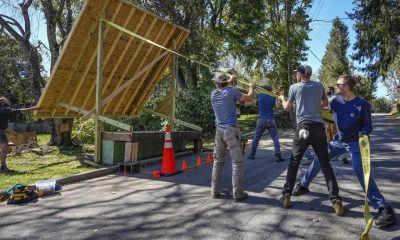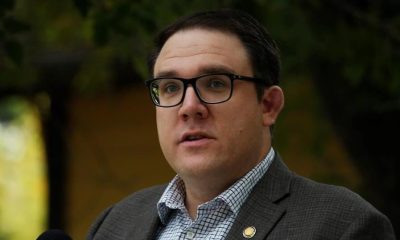Business
Why the power to keep Teck in Canadian hands rests with the federal government
:format(jpeg)/cloudfront-us-east-1.images.arcpublishing.com/tgam/KID2DBQ3B5DRDGXNYH5XJA46DE.jpg)
Teck’s Highland Valley Copper mine near Logan Lake, B.C.Handout
Teck Resources Ltd. TECK-B-T had hoped its plan to split in two would be a bulwark against a takeover by a foreign competitor. With that hope dashed, the power to keep Teck Canadian may rest with Ottawa.
Glencore PLC, GLNCY the Switzerland-based mining company and commodities trader, served notice this week that it intends to keep pursuing Teck, after the Canadian miner scrapped its plan to spin off its coal assets hours before shareholders were set to vote on the proposal.
Glencore has said that if Teck won’t negotiate a friendly deal it will take its offer, valued at US$23-billion, directly to the Vancouver-based company’s shareholders. From the standpoint of many investors, the question would be which option offers the best value.
But for the federal government, any deal with a foreign buyer would strike at the heart of its ambitions to position Canada as a major player in the race to transition to a low-carbon economy. The Liberals have pounced on the critical minerals that Teck strips from the earth – copper and zinc among them – as key to the future of the national economy. This week, they made it clear they would prefer that a Canada-based industry leader control those reserves at home, rather than an acquirer with an overseas head office.
“The government has been following developments closely and is in contact with the company and the B.C. provincial government,” Adrienne Vaupshas, a spokesperson for Deputy Premier Chrystia Freeland, said in a statement. “We need companies like Teck here in Canada – companies with a strong commitment to Canada.”
The comments followed a letter the government sent to the Vancouver Board of Trade, in which Ms. Freeland and her cabinet colleagues François-Philippe Champagne and Jonathan Wilkinson hinted strongly that they are counting on an independent Teck to play a major role in the country’s green transition. The minerals Teck produces are used to manufacture electric vehicles and renewable energy sources.
“This is all the more important today as we confront unprecedented geopolitical, economic, and environmental changes,” they wrote.
On Thursday, Ms. Freeland met with mining industry officials to get their views ahead of the first meeting of the Energy Transformation Task Force, a Canada-U.S. initiative aimed partly at building up the critical minerals supply chain between the two countries. The United States, bolstered by US$369-billion in green incentives in its Inflation Reduction Act, is both a partner and a competitor in the energy transition effort.
Ottawa is betting big. This month, it made a splash with billions of dollars in taxpayer support for a Volkswagen AG battery plant in St. Thomas, Ont. That is just one part of a larger strategy to establish a made-in-Canada supply chain for all things EV – critical minerals, auto parts, assembly, and the software and artificial intelligence to run it all. But Canada is not the only country trying to establish a foothold in what is seen as the industry of the future.
How much power does the government have to keep Teck out of foreign hands? A takeover by Glencore would go under the feds’ microscope as part of what is called a “net-benefit review.” In these reviews, the government assesses the impact of foreign investments on economic activity in Canada, including employment, production and capital levels.
With the government deeming copper and other metals critical to the future of the Canadian economy, Glencore or any foreign miner bidding for Teck would also be scrutinized through the lens of national security.
The government has plenty of latitude to block or place conditions on deals within the provisions of the Investment Canada Act, according to Bryce Tingle, the N. Murray Edwards Chair in business law at the University of Calgary. “I’m unaware of any time when its judgment of that act has been successfully challenged, and the act itself is worded broadly enough to give the government a great deal of discretion,” Prof. Tingle said.
Norman B. Keevil, Teck’s chair emeritus, also has veto power over any deal, as holder of a controlling position in the company’s supervoting A shares. He has said he’s not interested in selling the company to Glencore, but he has also said he would not exercise his veto power if the board, management and a majority of B shareholders wanted it. That would put the government in a key role.
In 2010, prime minister Stephen Harper’s Conservatives blocked BHP Billiton’s $38.6-billion hostile bid for Potash Corp. of Saskatchewan. After a net-benefit review, the government said a takeover by the Australian company would not have beneficial effects on Canada’s ability to compete in world markets, improve productivity or bolster its overall economic activity. The Saskatchewan government also opposed the deal, saying the fertilizer product amounted to a strategic interest.
“Maybe it was national security, but it also felt a lot like keeping a very important domestically owned company here in Canada,” Prof. Tingle said.
Teck’s now-scrapped plan to spin off its steelmaking coal assets was initially conceived in hopes of winning back some climate-change-conscious investors that had soured on the company, because of the assets’ high carbon emissions. Later, after Glencore entered the picture, the proposed split became a way of fending off the takeover bid. But too many shareholders balked at the arrangement, in which 90 per cent of the spinoff’s cash flows would have been sent back to Teck for an estimated 11 years.
Glencore had said its offer was contingent on Teck abandoning the spinoff. Under its plans, it and Teck’s coal assets would be merged. With Teck’s split off the table, Glencore is proceeding with its pitch.
Steven Tian, a corporate governance scholar at Yale University, said Glencore’s current and past ties to authoritarian regimes, including those in Russia, Kazakhstan, Qatar and the Democratic Republic of Congo, would be heavily scrutinized on national security grounds both in Canada and by the Biden administration, which would be consulted as part of a review.
“All of these governments are going to have a lot of questions about selling off one of the last and largest freestanding, independent copper miners in North America to a foreign company that frankly has a lot of ties to authoritarian dictators,” Mr. Tian said.
Around 15 per cent of Glencore’s current profits in its metals division come from the DRC and Kazakhstan.
Glencore’s less-than-stellar record operating abroad would likely also attract scrutiny on national security grounds. Last year, Glencore pleaded guilty to bribery and market manipulation in the U.S., and paid more than US$1-billion in penalties.
“Glencore paid more in fines last year than Teck made in profits,” Mr. Tian said. “That is astounding to me.”
British Columbia Premier David Eby has also raised the issue of Glencore’s fines, while lauding Teck’s record on environmental and Indigenous issues.
But Jack Mintz, President’s Fellow of the School of Public Policy at the University of Calgary and a corporate director, said the government’s clout could be limited in this case. Glencore can argue it has well-established operations in Canada, including copper, nickel and zinc mining and processing, agricultural facilities and consulting. It employs 9,000 full-time staff and contractors in the country.
Putting restrictions on foreign companies would not help in the quest to develop critical minerals, he said.
“Why does Canadian ownership of Teck matter for the development of critical minerals here? We already have many mining operations that are foreign controlled, and they are already in the most significant critical minerals, which are zinc and nickel.”
With a report from Niall McGee
Editor’s note: This story was edited to remove reference to Centerra Gold’s Kumtor mine.

Business
All Magic Spells (TM) : Top Converting Magic Spell eCommerce Store


Product Name: All Magic Spells (TM) : Top Converting Magic Spell eCommerce Store
All orders are protected by SSL encryption – the highest industry standard for online security from trusted vendors.

All Magic Spells (TM) : Top Converting Magic Spell eCommerce Store is backed with a 60 Day No Questions Asked Money Back Guarantee. If within the first 60 days of receipt you are not satisfied with Wake Up Lean™, you can request a refund by sending an email to the address given inside the product and we will immediately refund your entire purchase price, with no questions asked.
Business
Turn Your Wife Into Your Personal Sex Kitten


Product Name: Turn Your Wife Into Your Personal Sex Kitten
All orders are protected by SSL encryption – the highest industry standard for online security from trusted vendors.

Turn Your Wife Into Your Personal Sex Kitten is backed with a 60 Day No Questions Asked Money Back Guarantee. If within the first 60 days of receipt you are not satisfied with Wake Up Lean™, you can request a refund by sending an email to the address given inside the product and we will immediately refund your entire purchase price, with no questions asked.
Business
CPC Practice Exam


Product Name: CPC Practice Exam
Click here to get CPC Practice Exam at discounted price while it’s still available…
All orders are protected by SSL encryption – the highest industry standard for online security from trusted vendors.

CPC Practice Exam is backed with a 60 Day No Questions Asked Money Back Guarantee. If within the first 60 days of receipt you are not satisfied with Wake Up Lean™, you can request a refund by sending an email to the address given inside the product and we will immediately refund your entire purchase price, with no questions asked.
-

 News20 hours ago
News20 hours agoDefying Convention to Deepen Connections: Booking.com’s 8 Travel Predictions for 2025
-

 News6 hours ago
News6 hours agoAfter hurricane, with no running water, residents organize to meet a basic need
-

 Sports7 hours ago
Sports7 hours agoIn The Rings: Curling Canada still looking for Canadian Curling Trials title sponsor
-

 Politics7 hours ago
Politics7 hours agoN.B. election debate: Tory leader forced to defend record on gender policy, housing
-

 News7 hours ago
News7 hours agoAlberta government shifts continuing care from Health to Seniors Ministry
-

 News7 hours ago
News7 hours agoBuhai, Green and Shin lead in South Korea after 8-under 64s in first round
-

 News7 hours ago
News7 hours agoManitoba government halts school building plan, says other methods will be found
-

 News6 hours ago
News6 hours ago‘Significant overreach’: Ontario municipalities slam province over bike lane rules
























